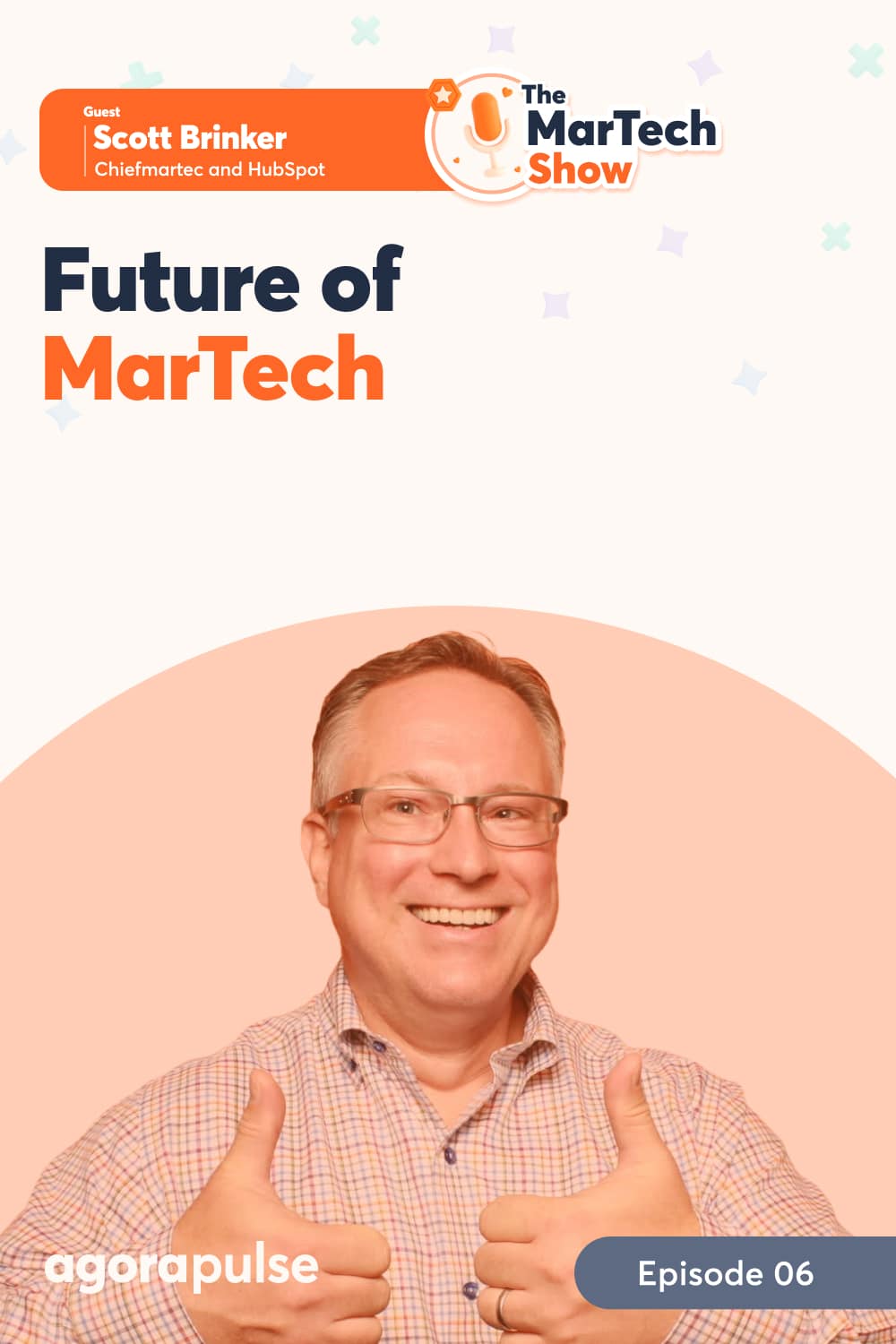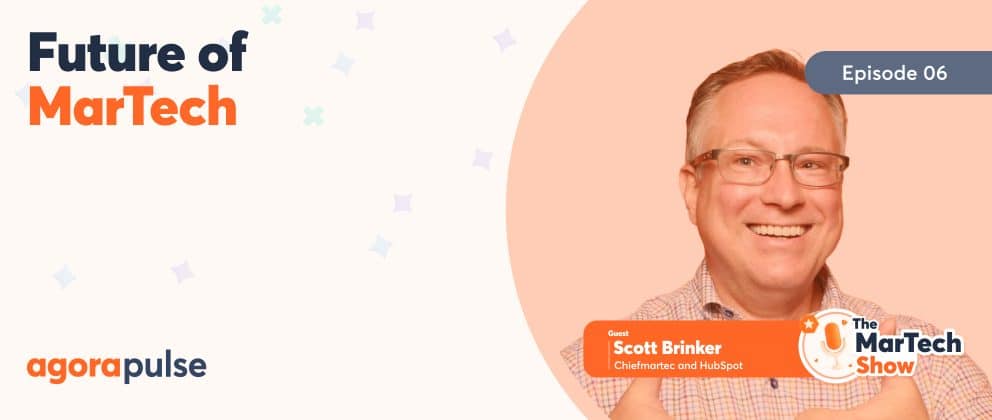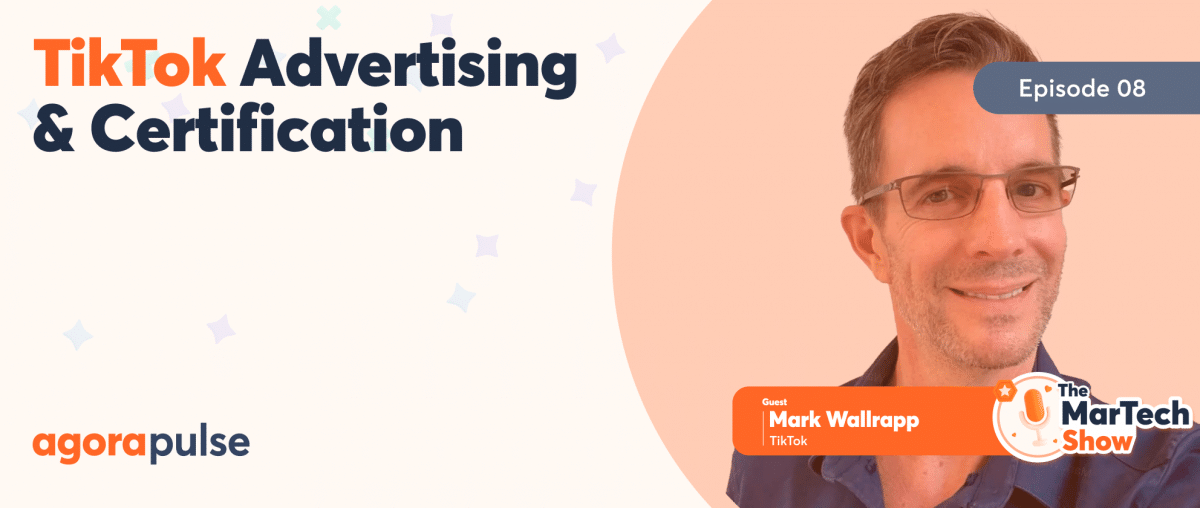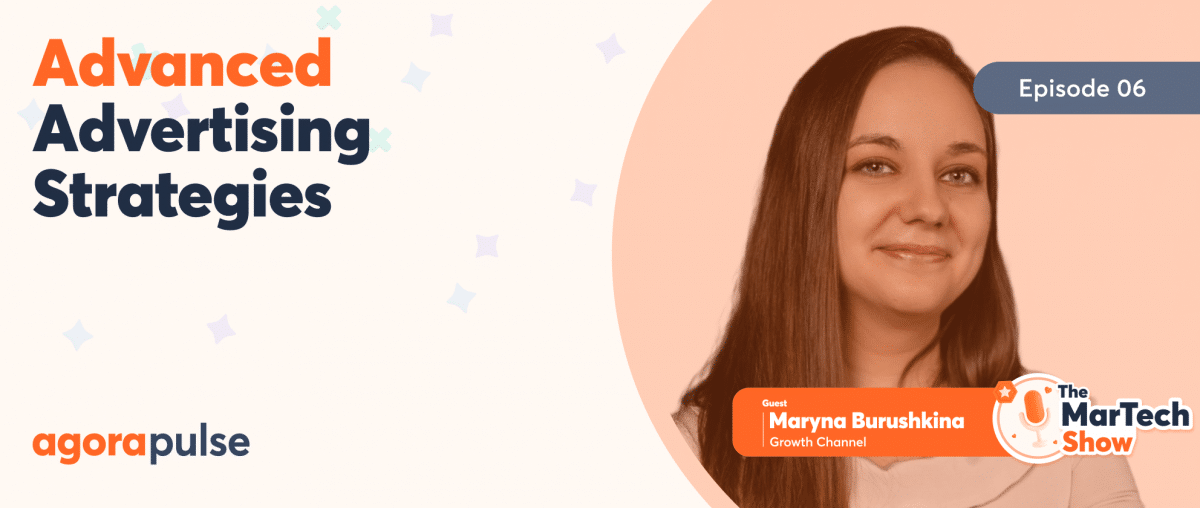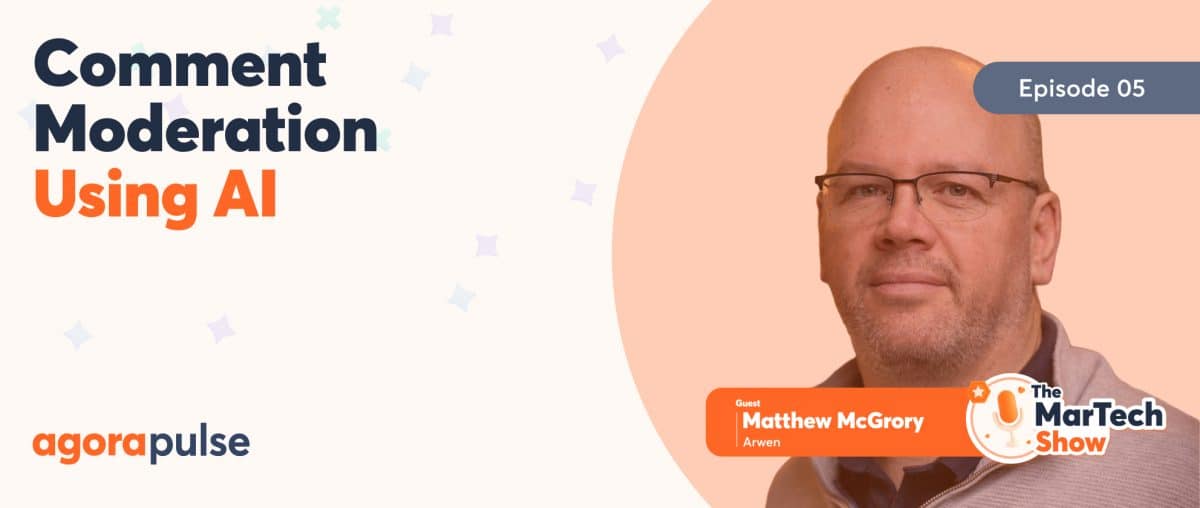The marketing technology landscape has now exploded to over 14, 000 products and solutions covering everything from advertising to social media and relationships from business intelligence and interactive content to data visualization and compliance and privacy.
How do we process all this rapid growth and what takeaways can we glean from the past year’s developments?
Find out in this episode of The MarTech Show with guest Scott Brinker and host Mike Allton, head of Strategic Partnerships at Agorapulse. Listen to the entire podcast episode below or read on to get the highlights.
Scott Brinker has been analyzing marketing technology and its impact on marketing organizations for more than a decade as the editor of the Chief Martec blog, and he serves as VP of platform ecosystem at HubSpot, helping to grow and nurture the company’s community of technology partners. He authored the bestselling book Hacking Marketing, and co-authored the bestseller The New Automation Mindset. And he holds degrees in computer science from Columbia University and Harvard University and an MBA from MIT.
The State of MarTech Reports
Mike Allton: How you came about with that. So happy to have you. Let’s just dive right in because I want to start with a little bit of context.
Tell us about the state of Martech Reports that you’ve built.
Who else is involved in that and how long have you been doing it?
Scott Brinker: Sure, so Frans Riemersma runs Martech Tribe. He and I have been collaborating here for the past three years on both the marketing technology landscape, which has grown from where it started like 13 years ago with like 150 products to the craziness, you know, that we just recently released of over 14, 000. So I’ve been very grateful to work with Frans over these past few years, collectively.
And how we build and maintain that and then we sort of got into a mode where like, okay, listen, we want to release this, we want to celebrate MarTech, the people who work in MarTech marketing operations. So we suggested that there should be a MarTech Day. I mean, there’s a day for everything out there on the planet.
So, May 1 for MarTech Day … We figured we would release the MarTech landscape on that day. By the way, in 2027, that intersects with Star Wars Day as well, too, which for me, like Martech and Star Wars, they come together. We figured, okay, well, you know, it’s not just about seeing a whole bunch of tiny microscopic logos on a slide. I know how much everyone enjoys that annual eye test for everyone in this industry. But stepping back from sort of the shock factor of that and diving into what are the dynamics that are actually evolving in the industry, both around the product landscape and what’s in there.
But also more importantly, how are things changing about the way people architect and structure and incorporate these marketing technologies into their lives into their business?
So that’s what the State of the MarTech Report is, dives into from a few different angles and, yeah, happy to talk with you in more detail about it.
Mike Allton: For those of you listening, we’ll have links in the show notes. Cause if you haven’t actually seen the landscape slide that Scott just mentioned, it’s this massive PDF with tiny microscopic logos in different categories of marketing technology, like social media marketing and so on. And beyond that, they’re actually clickable. So you can mouse over them and click through to their websites. It’s an enormous amount of work today. It was an enormous amount of work 13 years ago. As anyone who’s ever tried to program a link in a PDF can attest what to do. Over 10, 000 of those, 14, 000 of those. That’s incredible.
Scott Brinker: Incredible is one adjective, you know, other adjectives that are perhaps slightly less flattering but, yeah, it’s a project.
Robin Dimond: I feel like that leads us into like the next thing before we dig into specifics.
What stood out or surprised you at a high level doing this?
Scott Brinker: There were actually a number of surprises this year.
Artificial intelligence (AI)
So I guess one thing that wasn’t a surprise was the fact that these LLMs, these generative AI engines that got released starting about a year and a half ago, but boy, they have just proliferated throughout the marketing industry.
There are a whole bunch of industries, but certainly marketing. And some of this has been existing MarTech products that have added-in generative AI functionality to their products. But it’s also spawned this incredible explosion of all sorts of new little startups and MarTech projects that are leveraging those tools. It’s just a very fluid and experimental stage for what’s happening. And so when we actually tallied it up to see something like 3, 000 new products, introduced in MarTech here just over the past year, the vast majority of them have been something, that’s leveraging these generative AI capabilities.
And … how many of those are actually sustainable businesses? That’s a different angle to this. [It] will be interesting to sort of see which ones actually do turn into businesses, which ones get absorbed, by existing companies.
So I expect we’ll see quite a bit of evolution in that landscape in the year ahead.
Reduced churn
But the other thing that was actually really surprising about the landscape itself this year was how little churn there was from 2023 to 2024. It was one of the lowest years of churn, 2.1 percent, in the history of the MarTech landscape.
That was particularly surprising because 2023 was a really tough year for the SaaS industry. Tough year for a lot of industries, but certainly SaaS. I think there was the expectation that a lot of these MarTech companies from 2023 aren’t going to survive until 2024. And the reality is actually most of them have.
Some of them might be mortally wounded. Some of them may have been acquired but haven’t yet been absorbed into the mother ship. I do expect we’ll see that change here over this next year. But one of the interesting reflections we had on it is when you actually stop and think about it, SaaS companies are kind of hard to kill.
Once you actually have a set of subscribers, you’re providing value to them … And so while I am sure we will see these iterative waves where some of the attempts at creating MarTech products that ultimately didn’t pan out will go away, it kind of makes sense that they’re not going to all go away in one month.
And it might be actually sort of a long trip before we actually see that shuffling happen.
Mike Allton: That makes a lot of sense to me. There was a tool that I used to use. I still do technically, that is for amplifying blog content. You go in there and you join groups of other people with similar interests. And when you have a new blog post via RSS feed, they all see it and maybe they share it to their social media and so on. That was a bought or sold a decade ago and they’ve had like zero development, zero features, zero iteration since then. And it’s just kind of limped along. And every year, every other month I look at it, I’m like, How are you still alive?
But to your point, they probably have very, very minimal overhead, if anything. So they can continue to limp along. But you mentioned AI. And one of the things I want to ask you to kind of pick apart for us a little bit was that I know similar to how HubSpot has this whole ecosystem of apps and app providers, open AI and the ChatGPT have this ecosystem of custom GPTs. And a lot of these kind of feel like maybe they’re their own apps. Was that reflected in that, that landscape or what’s the distinction there?
Scott Brinker: Yeah. So this was an interesting philosophical discussion, around that. So what we did was we looked at actually thousands of GPTs, from OpenAI’s store. And the decision we made was: If there is a separate website where someone’s actually selling a product that GPT is a part of, then okay, that may qualify here to be a part of the MarTech landscape because it is kind of represented out in the world as an independent entity. If it’s simply just a GPT that’s available in the OpenAI GPT store, we’re not going to put it on the landscape. and so there was something like another 3,000 marketing-related GPTs that we just disqualified as a result.
But it was an interesting discussion because you’re like, can we get to a place where these custom GPTs, why are they not as legitimate of a MarTech product or solution, as sort of any other standalone like SaaS product, that’s out there?
And I think this is going to be a question we’re going to have to face a lot. More in the next year or two ahead is the whole nature of generative AI and how it’s showing up and the evolution this has on even how we get work done, how marketers engage with things, it’s shifting.
And so the MarTech landscape isn’t going to look the way it looked like 10 years ago. It’s going to be different. Something kind of different in the years ahead. Maybe at some point here, a GPT agent becomes one of the more powerful pieces of MarTech in your stack.
Mike Allton: Well, I think that’s definitely true. And now we have a hack to get on the 2025 landscape. I can just sell a 5 ChatGPT from my website and I qualify …
Robin Dimond: I think it’s incredible. And where you’re talking about, this is the part that excites me. To hear these things and what you’re saying yeah, it’s changed. There’s 2023, 2024.
In your report, you talked about the first and second stages of martech, and it seems really important for people to understand these distinctions. So if you wouldn’t mind just sharing where marketing technology is going, can you break these down for us?
The First and Second Stages of MarTech
Scott Brinker: Sure. So the way I characterize the first stage of MarTech, which I sort of roughly put is like the 2010s to, you know, 2020 was, it was largely about dichotomies. So like in software, the big debate was, is it suite versus best of breed?
Another dichotomy was: Are you a services company or are you a software company? And then even for individual businesses thinking about how they would implement MarTech, it was a choice between: Are we going to build it or are we going to buy it? And regarding some of these dichotomies, people would have brutal fights. Maybe not like physical fistfights. Maybe there was one, but there’d be vigorous debate around: Should we build? Should we buy? Are you a services company? Are you a software company? Should you go suite or best of breed?
And what we anticipated has absolutely come to materialize here is in the second age, which is really in this decade. We’ve gone from these dichotomies to those things largely converging. So for instance, instead of suite versus best of breed for almost everyone, I want both. I want these platform ecosystems where, yeah, I’m probably going to have one or two major products that are the backbone of my stack, but then I want to have all these specialist apps that I have the option to plug into that backbone and integrate it.
Instead of this hard dichotomy between software and services, we now see a ton of software companies that offer services … We sometimes label it under customer success, but what is it about? It’s about actually teaching customers how to be successful with the software, not just giving them a subscription.
… There are no barriers to creating software.They’re sort of taking some of their secret sauce that they’ve used in services, they’re packaging it up into products.
Maybe they’re using these products as a way to attract new business. Maybe they’re doing it as a way to make more efficient operations. Maybe it’s a way to extend relationships with clients, a whole bunch of interesting things happening, but now, yeah, you look at these business models and they are very often a blend of software and services.
And then even like the build versus buy arguments, they’re kind of fading to where people are like, well, listen, we don’t want to reinvent the wheel, so we’re going to buy any of these commercial platforms. Even things like obviously the hyper scaled solutions out of AWS and Google Cloud. But then on top of these platforms, we absolutely want the freedom to create specific experiences, workflows and custom apps that are unique to our business because we’re actually implementing this stuff as part of a digital operating system for our business. And our digital operating system is a little bit different than frankly everybody else’s digital operating system.
So we’ve kind of gone from the world of A versus B to A and B happily ever after.
Robin Dimond: How you just worded that, that’s perfect. I think every single person is going to sit here and agree with you and [say] he’s spot on.
I feel like he sat in my meetings for the past decade, listening to these conversations.
Scott Brinker: Well, that doesn’t happen too often. you know, it happened once. Everyone agrees.
Mike Allton: So Scott, there’s a substantial section of that report dedicated to this idea of composability.
What Is Composability?
Can you share what that is and why it’s a critical concept to today’s technologies?
Scott Brinker: Composability has become a bit of a buzzword in MarTech, like we talk about composable CVPs or composable DXPs, and I think for a lot of normal folks the word sounds really techie and weird, but the concepts are really straightforward, right?
The typical metaphor is this idea of Lego blocks. If I’ve got the Lego blocks, I can reconfigure them however I want for the specific thing I want to build. and the truth is we’ve been doing composability in tech for years. The techie version of that is software developers, anytime they build a product now, they don’t build it entirely from scratch. They’re leveraging all sorts of libraries or APIs in the cloud. And these become the building blocks, which they then create something original. But they’re leveraging a lot of the components to make that happen.
On the complete non-technical side of it, the metaphor I’d use would be spreadsheets. I mean, what is a spreadsheet? It’s basically a way for any business user to say like, “Oh yeah, I want to take some data from here and some data from here and I want to be able to mash it together and then get something new out of that.”
So we compose things all the time in tech. I think what we really see as like a composability movement in MarTech, it goes to this thing we were talking about with the first stage versus the second stage, is instead of like suite versus best of breed, or build versus buy, what we’re saying is largely companies want to get these commercial solutions.
When they bring these commercial solutions together, they want to have a lot of flexibility in, okay, how do we use the different capabilities across our integrated MarTech stack to build a workflow that is unique to our business, to build a customer experience that is unique to our business to put sort of any of that digital operating system in place, that’s going to be unique to the business.
And you do that by composing these capabilities from across these different products. And again, that sounds really techy, but in practice, people are doing this even with no code tools, you know, a little workflow automation tools, you know, Zapier is big in this stuff.
I think now people see with generative AI, you’re starting to have these interfaces where, okay, if I can just describe in natural language, what it is I want to have happen. The generative AI engine can go ahead and say let me compose that thing you want from this piece here, that piece there, and okay, here you go.
So anyways, composability is how do we get out of a world where we are adapting our businesses to the software, and instead, we’re all in a position where we can have the software adapt to our businesses.
APIs
Robin Dimond: Amazing. And I think that’s something that we all need to be thinking about. You talked a little bit about APIs, so can we go back to that?
Now, we know many businesses have reported that APIs, integrations, and how important they are to evaluating their new solutions, but what do you think about the capability? How important is that capability?
Scott Brinker: So APIs are how we do the composability? In fact, actually, if we even go back from the composability side of it, just talk about getting things integrated. I mean, if there’s been one story that has been consistent throughout the entire history of the Martech landscape, it’s been, wow, it’s amazing that there’s all this innovation out here and all these cool apps. But if I can’t get them to actually integrate with my overall marketing operations, my overall marketing stack, it doesn’t matter. It’s like the tree that falls in the forest, you just can’t hear it. And so everyone, I mean, survey after survey after survey, year after year after year, marketers are like, hey, integration is one of the most important things to us for good reason.
And so composability is just almost even like the next step of the saying, like, okay, once we even have these things integrated, now we can sort of start to reconfigure the way our business runs, you know, across these integrated apps.
APIs are simply the technical mechanism under the covers of how this happens. And so one of the things we uncovered from this recent report in studying with, like 168 MarTech and marketing operations leaders is they take APIs very seriously when they’re now evaluating products that. [It’s] one of their top three requirements for the largest percentage of people like, yeah, let’s make sure this has the API capabilities because they just know that’s the key.
Mike Allton: Thanks for asking that, Robin, and thanks for answering, Scott. I know at Agorapulse a few years ago, we were trying to talk to our own existing clients, and they were saying, we want integrations, we want integrations, but they couldn’t articulate why, and so that was a challenge and a stumbling block for our development team.
They’re like, if we don’t know why you need this, then we’re not gonna spend a lot of time developing it. If we don’t understand the use case today, that’s a different story. We’re talking to more people and we’re seeing fantastic reports like yours that better articulate, not just, yes, we all want integrations, but here’s why, here’s what we expected to actually do so that can inform the developers as you mentioned.
But as you’ve thought about this report and these conversations that you’ve had, you’re seeing so much happen in the industry, but I’m wondering what’s disappointing you? We’ve got less churn, which is great. Development is changing. Investment in the industry is changing. Is there anything that you were seeing that you’re like, ah, I don’t like to see that?
Disappointments About the MarTech Landscape
Scott Brinker: Gartner, at least for the past few years, has published a survey, where they ask a bunch of marketing leaders, what percentage of your MarTech stack are you actually utilizing?
It started as something like 60%, which you could argue wasn’t great to begin with then it dropped to 40 percent and then like the past year, it dropped down to like 30 percent. This is terrible. People have all this huge investment in this marketing technology and essentially they’re coming to the conclusion that they’re not actually able to harness it.
Now, I think a lot of people, their initial reaction to that is, okay, well that’s the fault of the tech company. Why are you building this stuff that people can’t use? I’m not saying that I don’t think the MarTech vendors that there aren’t ways that they can improve. But my impression is the bigger challenge is we as a profession, as a discipline around MarTech and marketing operations, have under-invested in the training. The enablement, we talk a lot about sales enablement and all this work we do to help salespeople be effective in their roles.
Marketing enablement! Marketers have just had so many new capabilities, so many new tactics that they’re being asked to engage in, so many new channels. But the amount of actual support we give them and like the structure we do for not just for one-off trainings.
It’s impossible for anyone to keep up with all of this, but if we want our teams and we want our organizations to take advantage of as much of this as possible, boy, I think we need to invest a heck of a lot more in the actual marking and enablement capability.
Mike Allton: That’s a great observation. We talked a little bit about this in a previous episode with the CMO of Uptempo when he was talking about marketers just wanting to buy this stuff that looks fantastic without building a lot of internal use cases. And, you know, to your point, going through the training and frankly, wasting a lot of money.
Robin Dimond: I want to reiterate this and I want to put it all over the place because what you said is so imperative. Things are happening at such a fast pace. Like, look at this report! There are things that are outside of our control that are happening and marketers are being pulled and stretched and they’re shrinking teams but also not training them. You’re investing in your sales team, but your marketing team is your sales team.
And when people start realizing marketing and tech work together, it’s now they’re going to realize marketing and sales. That’s the forefront of your going out there. And I think what you said is so imperative for business owners that in a world to stand out right now, they need to.
Scott Brinker: So if I can add on one thing, that, so there was a study last fall by the corporate board, then they asked a whole bunch of junior, mid-level and senior marketers, how are you learning about AI?
The most popular things were like, oh, well, I read about it, or I like to watch a video on the web. And then some of them were like, oh, I sort of experiment with this on my own time, you know, and oh yeah, maybe I talked to a couple other people I know in the industry. Way down at the bottom of the list, it was literally like, you know, other than the other category dead last was, oh, I actually get officially trained on how to use this stuff by my company.
It was single digit or low double digit, like 10%. This is crazy. This stuff has been out here for a year and a half. And most marketers are not getting any official support from their organizations in how do we actually take advantage of this?
What do you see in MarTech in 2025?
Scott Brinker: All right, well, I will caveat by saying that one of the reasons I do the MarTech landscape is because I’m absolutely terrible at predicting. So the MarTech landscape is just sort of an empirical assessment of this year, so we can look back.
Looking forward, it’s hard. That being said, I would frame this as the thing I am most excited about over this next year is, I think these generative AI interfaces, these natural language interfaces.
I mean, even we were just chatting before the show here about ChatGPT’s new 4.o model, and this interaction mode where you can talk to it. This is actually a huge net new paradigm in how people interact with software. In the past, the entire era of SaaS has all been point and click. It’s like, okay, well, if I want to use a capability in software, I have to figure out the menus and then I go from this menu to that menu and I get to this screen.
And what are my configuration options? And do I understand this dropdown? You know, when you get to these more sophisticated platforms, this is one of the reasons why we have all these like, you know, specialist admins and Ops folks is because it’s a career just learning how to navigate the software. Not even just the things that you want to do, but how do I navigate the software to make it do what I want to do?
And I think this is one of the things that’s actually created a ceiling to how sophisticated some of the MarTech can get because like, hey, listen, we could make it more sophisticated, but is anybody actually going to be able to use it?
And what is so exciting is you see these natural language interfaces and sort of these other kinds of new modes of like, oh, well, if I can just talk to the software, is this actually what I want to do? Could you compare these things to it? It could ask clarifying questions. It could bring up one version. I’m like, no, no, don’t change that one. Can you bring the data set? You know, how did that compare to last year? This is going to unlock the democratization of the number of people across marketing who are actually going to be able to tap in to the power that we have. Even with today’s existing martech, it’s going to be amazing.
I kind of feel once we get beyond that barrier of saying, like, listen, you don’t have to memorize screens and screens and screens of different menus and navigation options and configurations like that, if you can just simply talk to the software about what you want, it can instantiate it. I mean, again, I’m excited about this. This is the sort of stuff it would seem like it would be science fiction. My suspicion is we will see enough of that start to look realistic here in 2025, that it’s going to change, change the game for everyone.
Mike Allton: That’s such a powerful point. I actually went to college for programming, which meant me using a keyboard. This is the cavemen of programming, right? Text is barbaric today. Now you can just, as you said, speak to the AI and say, you know what? I’d like to see some code that does this and it will just do it and you can move on to the next thing and then compose much and much more advanced.
This has been fantastic, Scott. Thank you so much. This is such an important topic for everybody to listen to, but for those who want to know more about you, about the report, where should they go?
Scott Brinker: Sure. My blog is, chiefmartec.com without the h at the end. Long story on that. so yeah, feel free to go there and you can get a copy of the report.
Thank you for listening to another episode of the MarTech show hosted by Robin Diamond and Mike Allton powered by Agorapulse, the number one rated social media management solution, which you can learn more about at Agorapulse.com. If you want to make sure you’re part of our audience during live weekly broadcasts, take a look at our calendar at Agorapulse.com/calendar, or click the subscribe button in your email. Once you register for any of these events, is there a particular tool or topic you’d like to see us talk about, or perhaps you think your solution should be featured?
Mike Allton: Email me at mike@agorapulse.com.
